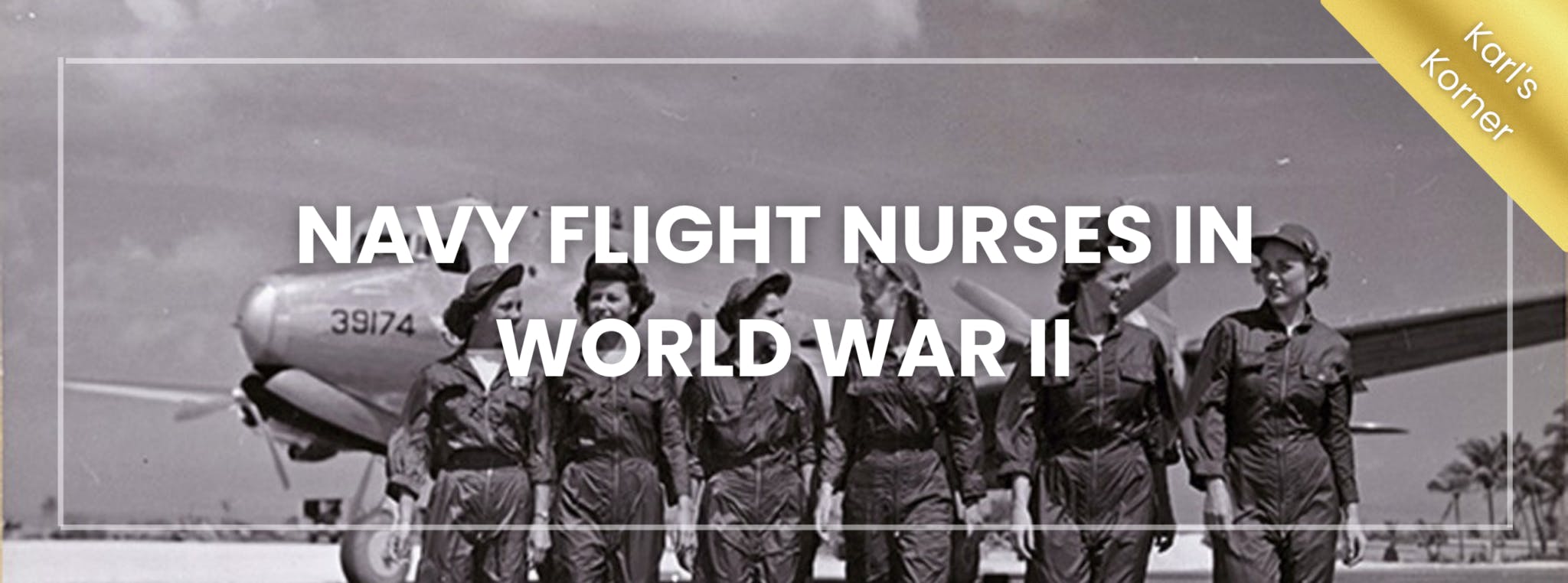 June 23, 2023 | Karl’s Korner
June 23, 2023 | Karl’s KornerNavy Flight Nurses in World War II
Advances in aviation by the 1940s offered an opportunity to expedite the transport of wounded personnel from the battlefield to established hospitals, even thousands of miles away from the front lines. By the start of the North African campaign in late 1942, the U.S. Army Air Forces employed a specialist branch of the Army Nurse Corps trained in caring for wounded aboard aircraft.
It did not take long to discover that air evacuation encompassed much more than simply flying wounded from one point to another. Severe cases could shift suddenly in flight, and trained personnel with skills beyond what ordinary aircrew or corpsmen could administer were needed.
By 1944, the Navy faced immense distances and ever-increasing casualties as the fighting in the western Pacific grew more bitter. The evacuation techniques started in 1942 and became more professionalized as the war progressed and on Dec. 10, 1944, the Navy Nurse Corps established a program for Flight Nurses at Naval Air Station Alameda in northern California.
The eight-week program was headed by a former United Air Lines stewardess, who was a registered nurse. Mary Ellen O’Connor, who emerged from the pioneering age of passenger flight when stewardesses were required to be nurses, had already amassed two and a half million flight miles.
Duties and Impact of Flight Nurses: Providing Critical Care in Challenging Environments
In addition to being qualified nurses, the young women trained in this program endured a regimen that included instruction in specialties like aviation physiology and aircrew survival, treatment for shock, redressing wounds, and caring for patients in cold, un-pressurized aircraft environments. Water survival training was also required, where the Flight Nurse candidate had to demonstrate underwater swimming proficiency, complete a mile swim, and tow a patient nearly a quarter mile in ten minutes.
Duties in flight included starting IVs and applying medical oxygen, procedures usually reserved for physicians. As commissioned officers, Flight Nurses normally outranked other medical personnel aboard, as evacuation flights did not include doctors. Service in the Pacific meant lengthy overwater flights with practically no options for emergency diversions for patient situations.
In January 1945, the first class of twelve received their wings, and half were sent directly to Guam to prepare for battlefield evacuations. The rest of their classmates evacuated casualties from Hawaii and across the continental U.S.
Ensign Jane Kendeigh: The Pioneering Navy Flight Nurse
On March 6, Ensign Jane Kendeigh landed on the remote island of Iwo Jima while fierce fighting continued on and assisted in bringing desperately wounded to rear area hospitals. Kendeigh’s notoriety as the first Navy Flight Nurse in an active combat zone drew her into a War Bond Rally stateside. Still, she soon requested a return to the combat zone. She arrived at Okinawa just one week after the invasion began in April. By then, the Navy had more than 70 Flight Nurses on duty.
Air Evacuations in Okinawa and the Importance of Swift Medical Care
Okinawa was the costliest naval campaign of the war, and naval air evacuations edged out surface evacuations by ship in that campaign – 11,771 to 11,732. Hospital space in Okinawa during the campaign was tight, and swift evacuations to hospitals in the Marianas became a priority.
Even after the war ended, Flight Nurses were on hand for another type of evacuation flight: liberated prisoners of war being repatriated after years of brutal wartime confinement.
Today, Navy Flight Nurses are now Nurses with a military rating as en-route care Specialists. They provide evaluations and real-time health maintenance for wounded transported by air over oceans and continents. They carry a legacy of keeping patients alive “under their wing” as their forebears did in World War II.
Launch em’… until next time,
Karl
Your Adventure Starts Now
Your email is the key to information that will open up all your possibilities for exploring the mighty Midway!

